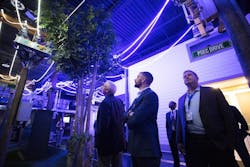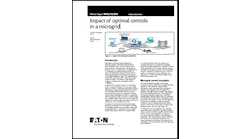Denise Brinley was surprised by the array of businesses drawn to a summit on microgrids held this week in Pittsburgh by power management company Eaton.
For her it was an actionable discovery — she’s senior energy advisor of the Pennsylvania Department of Community and Economic Development.
“I walked away with the distinct impression that there are any number of businesses that are interested in seeing this kind of technology flourish in Pennsylvania. And when businesses become interested, it means there is a viable market,” said Brinley in an interview following the “Pennsylvania Resiliency through Microgrid Summit,” held Wednesday at Eaton’s Experience Center. The facility houses a working microgrid that powers lighting, HVAC and facility loads from multiple generation sources, including solar, energy storage and natural gas generation.
The Eaton Experience Center near Pittsburgh, courtesy of Eaton
Brinley was among business, utility, university, hospital, transportation, industry, government, civic and community leaders who participated in the event.
“I see this conference as the platform for developing strong partnerships on helping to move things in whatever direction they need to go to make microgrid development easier in the Commonwealth and more productive,” she said.
Pennsylvania already stands as one of the industry’s innovators, given the microgrid at the Philadelphia Navy Yard, one of the largest private microgrids in the US. Pittsburgh, itself, has a grid-of-microgrids project on the drawing board. And the Allegheny County Airport Authority also is planning a microgrid. Earlier this year, the authority received 64 responses to its solicitation expressions of interest seeking a developer to design, build, own and operate a microgrid at the Pittsburgh International Airport.
In addition, legislation (HB 1412) is pending before the Pennsylvania House of Representatives that clears the way for utilities to build microgrid pilot projects and recover their costs through rates.
“Just the idea that there is legislative action moving on this means the conversation is starting to broaden,” Brinley said.
In Pennsylvania the microgrid discussion is intertwined with the state’s natural gas market. Pennsylvania producers more natural gas than any state besides Texas.
From left: John White, Eaton marketing director; PA State Rep. John Maher; Denise Brinley, senior energy advisor, PA Dept. of Community & Economic Development; Matthew Wurst, advisor to chairman, PA PUC; Paul Ohodnicki, materials scientist, NETL, DOE; Murali Baggu, laboratory program manager, NREL. Courtesy of Eaton
Brinley foresees microgrids, therefore, including natural gas combined heat and power (CHP) units, used in combination with renewables and energy storage to improve the resiliency of the state’s generation portfolio.
The state already offers incentives for both CHP and solar, but has not yet created funding to merge them into microgrids. That’s another thing Brinley began contemplating at the summit — what the state can do to build more resilient energy systems that decarbonize.
“We think that is in good alignment with Pennsylvania’s expertise and long storied history in energy production,” she said. “So we’ll have more work to do going forward.”
One area the stakeholders need to tackle is how to pay for resiliency, said John White, director of marketing at Eaton. “We had a user panel where they talked about the cost of resiliency, and there was a lot of conversation around who pays for that cost. There is a cost but there is obviously a value too.”
White sees the topic as a good one for public and private partners to advance together.
So look to Pennsylvania to tackle that issue and others as it continues forward on innovation, CHP, private/public partnerships — and a lot more microgrids.
Learn more about how companies like Eaton are expanding the microgrid market. Subscribe to the free Microgrid Knowledge newsletter.







